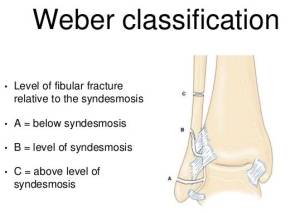Ankle Injuries
Ankle Fracture
Lateral Malleolar Fracture
- Weber classification according to proximity to syndesmosis
- walking boot - for isolated lateral malleolus fracture with < 3mm displacement, intact mortise and no talar shift
- if the mortise is well reduced, results from operative and non-operative treatment are similar
Medial Malleolar fracture
- walking boot - nondisplaced fracture and tip avulsions
- operative - any displacement or talar shift
Bimalleolar fracture
- POP cast - elderly or can not tolerate anaesthetic
- operative - others
Post Malleolar fracture
- walking boot - <25% of articular surface involved (CT measurement as XRay unreliable), <2 mm articular stepoff, syndesmotic stability
- operative - others
Treatment of ankle fractures is based on the stability of the ankle joint.
- Stable ankle fractures are those in which the talus remains centered under the tibia, meaning that no medial-sided injury (with resultant lateral shift of the talus) has occurred
- stable fractures are usually managed non-operatively with protected weight bearing.
Achilles tendonopathy
- tendinopathy is a degenerative not an inflammatory condition c/w tendinitis which is inflammatory
- Haglund's syndrome - triad of 1. insertional achilles tendinopathy, 2. retrocalcaneal bursitis, 3. Haglund deformity (i.e. posterosuperior calcaneal exostosis)
- tendinitis, tendinopathy and Achilles rupture have been associated with Fluoroquinolones (ciprofloxacin, levofloxacin, pefloxacin, and norfloxacin)
- has been seen within hours of 1st dose
- Low-dose corticosteroids in isolation have been implicated in Achilles tendon rupture but used concomitantly with fluoroquinolones increases risk
- fluoroquinolones should not be used in children because of the risk in load bearing cartilage
J Athl 2014. Tendonopathies and fluoroquinolones in athletes
achilles tendinopathy. J of sports med - a review 2002

